"Bronto" simple means "thunder" and today we are not talking about some trivial thunder lizards, we are talking about the ten times cooler mammal version, the brontotheres. Also known as:
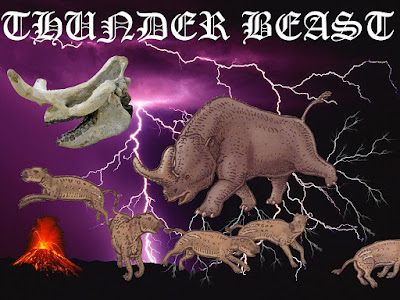 |
| Amy's new indie band name (drawings by Ray Troll) |
We would also like to take this moment to point out that brontoTHERES (1872) were named before brontoSAURS (1879) so while that's not such a big deal everyone should just know that thunder beasts are hip as fuck. Supposedly brontotheres earned this name because of the Sioux indians who were the first to discover the skulls of these bizarre-shaped megafauna. They believed the bones were from the these giant creatures who produced thunderstorms when running over the clouds and referred to them as 'thunder horses' (pretty on point considering brontotheres, like horses, are perissodactyls). The first white guy to look at the bones was none other than our titty-loving friend, Leidy. He examined a partial mandible found in 1846 in South Dakota and named the fossil Palaeotherium proutii.
Or something like that.
Now they are called brontotheres. But sometimes titanotheres. It gets confusing thanks to one of Amy favorite paleontologists, Henry Fairfield Osborn. Yes, Osborn, who once identified a pleistocene peccary tooth as a new species of human which he called Hesperopithecus, or "Nebraska Man", also made a mess of other extinct mammals. With brontotheres, Osborn went into full-blown "NAME ALL THE THINGS" mode, which was a common way of doing paleontology in the early 1900's. Osborn wrote two giant volumes on "The Titanotheres of Ancient Wyoming, Dakota, and Nebraska" and split brontotheres into eleven subfamilies (now we recognize three [Milhbachler, 2008]). He was a fan of the name "titanothere" over "brontothere" which is probably where most of the confusion between the names comes from.
 |
| An excerpt from Osborn (1929) |
ENOUGH HISTORY, more PREHISTORY! Who are these thunder beasts and why are they so weird?
Brontotheres lived during the Eocene (56 - 34 million years ago) of Asia, North America, and one weirdo brontothere who went through a goth-vampire stage and was found in Romania (no fangs, capes, or evidence of sparkling have been found yet, though). Brontotheres are probably best known for being really big and for having large frontonasal horns that protrude from the anterior portion of their skull (see below). They look vaguely rhino-like, but aren't rhinos. The earliest brontotheres like Palaeosyops and Eotitanops; however, were quite small and lacked the face horn. Brontotheres are also characterized by having a short face (portion of skull anterior to the orbits) and a long skull. They also are united by their unique bunoseledont dentition.
 |
| Brontothere upper molars on the upper left. Megacerops skull and artist reconstruction on the right and bottom. |
Brontotheres are perissodactyls. We talk about perissodactyls quite a bit on this blog because they are pretty effing cool but not as cool as artiodactyls, for obvious reasons (Meaghan studies artiodactyls, that's the obvious reason). Artiodactyls are even-toed hooved animals, and perissodactyls are odd-toed hooved animals. Brontotheres actually have four toes on their forelimbs and three toes on their hindlimb, but they are not hybrids. They're still perissodactyls.
The Perissodactyl Family Extant and Extinct
But we don't really know how brontotheres relate to everybody else in the perissodactyl group. Were they part of Ceratomorpha, along with rhinos and tapirs? Or in the poorly named-Hippomorpha which contains no hippos, just horses? Or perhaps they were neither - it's still not really clear.
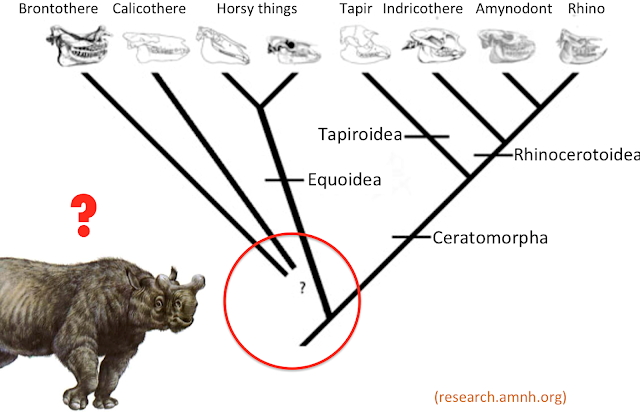 |
| ARE YOU MY EVOLUTIONARY MOMMY? |
Mihlbachler (2008) believes Lambdotherium to be the sister group to brontotheres and Lambdotherium is a North American fossil. This, along with the fact that the majority of the dispersal events of brontotheres was FROM North America TO Asia, led Mihlbachler to support the North American origins for brontotheres.
Beard (1998) disagrees. Beard supports an Asian origin for brontotheres as part of his "East of Eden" hypothesis in which North America serves as the cul-de-sac for multiple inoculations of mammals from Asia. His support for this origin is the Asian fossil Danjiangia pingi, who he claims is the sister group to brontotheres (Beard, 1998).
The Vengeance Team supports the eastern European hypothesis that brontotheres were really just vampire rhinos from Romania who took over Asia and North America until early felids wiped them out by evolving pure silver canines (Atwater, pers. com. 2016). We feel this is the most realistic version presented thus far.
To summarize thus far: We don't know to whom brontotheres are closely related and we don't know where the hell they came from. Brontothere identity crisis is real.
Brontotheres got really big in both Asia and North America throughout the Eocene and had some crazy frontonasal horn evolution going on. Megacerops is the largest brontothere in North America and it also sports the largest, most dramatic horn from that continent. Embolotherium is the largest brontothere from Asia, and its horn does not disappoint either.
 |
| Amy for scale. Totally accurate scale* *Totally sarcasm |
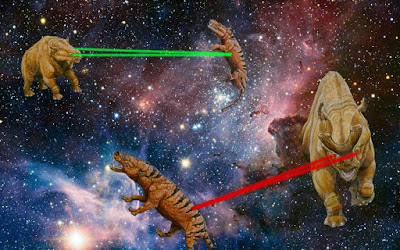 |
| For space combat, brontotheres evolved eye lasers. |
Brontotheres were really cool, alright?!? That's all the science we've got, but here are some more nerd photoshop collages for your enjoyment:
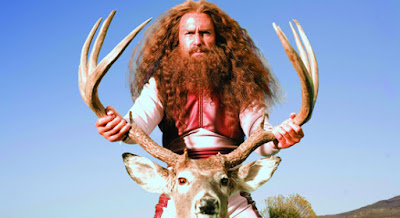 |
| You may have seen Gentlemen Broncos.... |
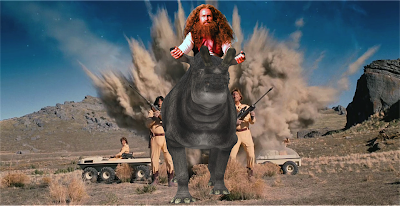 |
| ...But you've never seen Gentlemen BRONTOS! |
 |
| Another take on Gentlemen brontos (No, really, go watch Gentlemen Broncos) |
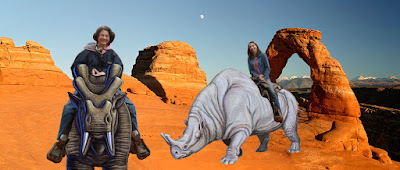 |
| Thanks for reading!!! Go find a brontothere today! |
More info:
http://whiteriver.weebly.com/brontotheres.html
Works Cited:
Beard,
K. C., 1998. East of Eden: Asia as an important center of taxonomic origination
in mammalian evolution. Bulletin
of the Carnegie Museum of Natural History. 34, 5-39.
Marsh, O.C., 1872. Preliminary description of new
Tertiary mammals. American Journal of Science and Arts. 4, 1-35.
Mihlbachler, M. C.,
2008. Species taxonomy, phylogeny, and biogeography of the Brontotheriidae
(Mammalia: Perissodactyla). Bulletin
of the American Museum of Natural History, 1-475.
Osborn,
H. F., 1929. The titanotheres of
ancient Wyoming, Dakota, and Nebraska. Government Printing Office. 55.


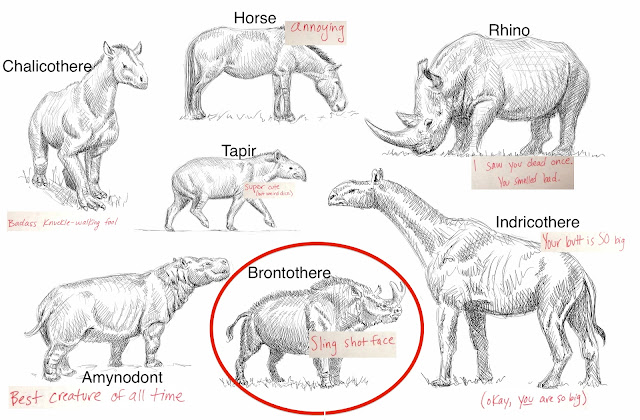

wtf
ReplyDelete